Polyethyleneimine-Functionalized Carbon Nanotubes Enabling Potent Antimycotic Activity of Lyticase
Abstract
:1. Introduction
2. Materials and Methods
3. Results and Discussion
Author Contributions
Funding
Institutional Review Board Statement
Informed Consent Statement
Acknowledgments
Conflicts of Interest
References
- Yemul, O.; Imae, T. Synthesis and characterization of poly(ethyleneimine) dendrimers. Colloid Polym. Sci. 2008, 286, 747–752. [Google Scholar] [CrossRef]
- Vancha, A.R.; Govindaraju, S.; Parsa, K.V.L.; Jasti, M.; González-García, M.; Ballestero, R.P. Use of polyethyleneimine polymer in cell culture as attachment factor and lipofection enhancer. BMC Biotechnol. 2004, 4, 23. [Google Scholar] [CrossRef] [PubMed] [Green Version]
- Remy, J.-S.; Abdallah, B.; Zanta, M.A.; Boussif, O.; Behr, J.-P.; Demeneix, B. Gene transfer with lipospermines and polyethylenimines. Adv. Drug Deliv. Rev. 1998, 30, 85–95. [Google Scholar] [CrossRef]
- Boussif, O.; Lezoualc’H, F.; Zanta, M.A.; Mergny, M.D.; Scherman, D.; Demeneix, B.; Behr, J.P. A versatile vector for gene and oligonucleotide transfer into cells in culture and in vivo: Polyethylenimine. Proc. Natl. Acad. Sci. USA 1995, 92, 7297–7301. [Google Scholar] [CrossRef] [PubMed] [Green Version]
- Rudolph, C.; Lausier, J.; Naundorf, S.; Rosenecker, J. In vivo gene delivery to the lung using polyethylenimine and fractured polyamidoamine dendrimers. J. Gene Med. 2000, 2, 269–278. [Google Scholar] [CrossRef]
- Akinc, A.; Thomas, M.; Klibanov, A.M.; Langer, R. Exploring polyethylenimine-mediated DNA transfection and the proton sponge hypothesis. J. Gene Med. 2004, 7, 657–663. [Google Scholar] [CrossRef]
- Yamano, S.; Dai, J.; Hanatani, S.; Haku, K.; Yamanaka, T.; Ishioka, M.; Takayama, T.; Yuvienco, C.; Khapli, S.; Moursi, A.M.; et al. Long-term efficient gene delivery using polyethylenimine with modified Tat peptide. Biomaterials 2014, 35, 1705–1715. [Google Scholar] [CrossRef]
- Sanz, R.; Calleja, G.; Arencibia, A.; Sanz-Pérez, E.S. Development of high efficiency adsorbents for CO2 capture based on a double-functionalization method of grafting and impregnation. J. Mater. Chem. A 2013, 1, 1956–1962. [Google Scholar] [CrossRef]
- Heydari-Gorji, A.; Belmabkhout, Y.; Sayari, A. Polyethylenimine-Impregnated Mesoporous Silica: Effect of Amine Loading and Surface Alkyl Chains on CO2 Adsorption. Langmuir 2011, 27, 12411–12416. [Google Scholar] [CrossRef]
- Sanz, R.; Calleja, G.; Arencibia, A.; Sanz-Pérez, E. CO2 adsorption on branched polyethyleneimine-impregnated mesoporous silica SBA-15. Appl. Surf. Sci. 2010, 256, 5323–5328. [Google Scholar] [CrossRef]
- Banar, M.; Emaneini, M.; Beigverdi, R.; Pirlar, R.F.; Farahani, N.N.; Van Leeuwen, W.B.; Jabalameli, F. The efficacy of lyticase and β-glucosidase enzymes on biofilm degradation of Pseudomonas aeruginosa strains with different gene profiles. BMC Microbiol. 2019, 19, 291. [Google Scholar] [CrossRef] [PubMed]
- Jewell, S.N.; Waldo, R.H.; Cain, C.C.; Falkinham, J.O. Rapid detection of lytic antimicrobial activity against yeast and filamentous fungi. J. Microbiol. Methods 2002, 49, 1–9. [Google Scholar] [CrossRef]
- Sachivkina, N.; Kravtsov, E.G.; Vasilyeva, E.A.; Anokhina, I.V.; Dalin, M.V. Study of antimycotic activity of lyticase. Bull. Exp. Biol. Med. 2009, 148, 214–216. [Google Scholar] [CrossRef]
- Scott, J.H.; Schekman, R. Lyticase: Endoglucanase and Protease Activities That Act Together in Yeast Cell Lysis. J. Bacteriol. 1980, 142, 414–423. [Google Scholar] [CrossRef] [PubMed] [Green Version]
- Bickerstaff, G.F. Immobilization of Enzymes and Cells; Humana Press: Totowa, NJ, USA, 1997. [Google Scholar]
- Chauhan, G.S. Evaluation of nanogels as supports for enzyme immobilization. Polym. Int. 2014, 63, 1889–1894. [Google Scholar] [CrossRef]
- Rodríguez-Restrepo, Y.A.; Orrego, C.E. Immobilization of enzymes and cells on lignocellulosic materials. Environ. Chem. Lett. 2020, 18, 787–806. [Google Scholar] [CrossRef]
- Yamaguchi, H.; Honda, T.; Miyazaki, M. Application of enzyme-immobilization technique for microflow reactor. J. Flow Chem. 2016, 6, 13–17. [Google Scholar] [CrossRef] [Green Version]
- Du, K.; Sun, J.; Zhou, X.; Feng, W.; Jiang, X.; Ji, P. A two-enzyme immobilization approach using carbon nanotubes/silica as support. Biotechnol. Prog. 2014, 31, 42–47. [Google Scholar] [CrossRef]
- Feng, W.; Sun, X.; Ji, P. Activation mechanism of Yarrowia lipolytica lipase immobilized on carbon nanotubes. Soft Matter 2012, 8, 7143–7150. [Google Scholar] [CrossRef]
- Tan, H.; Feng, W.; Ji, P. Lipase immobilized on magnetic multi-walled carbon nanotubes. Bioresour. Technol. 2012, 115, 172–176. [Google Scholar] [CrossRef]
- Pedrosa, V.A.; Paliwal, S.; Balasubramanian, S.; Nepal, D.; Davis, V.; Wild, J.; Ramanculov, E.; Simonian, A. Enhanced stability of enzyme organophosphate hydrolase interfaced on the carbon nanotubes. Colloids Surfaces B Biointerfaces 2010, 77, 69–74. [Google Scholar] [CrossRef] [PubMed]
- Wang, S.; Zhang, Q.; Wang, R.; Yoon, S.; Ahn, J.; Yang, D.; Tian, J.; Li, J.; Zhou, Q. Multi-walled carbon nanotubes for the immobilization of enzyme in glucose biosensors. Electrochem. Commun. 2003, 5, 800–803. [Google Scholar] [CrossRef]
- Fujigaya, T.; Nakashima, N. Non-covalent polymer wrapping of carbon nanotubes and the role of wrapped polymers as functional dispersants. Sci. Technol. Adv. Mater. 2015, 16, 024802. [Google Scholar] [CrossRef] [PubMed]
- Chen, R.J.; Bangsaruntip, S.; Drouvalakis, K.A.; Kam, N.W.S.; Shim, M.; Li, Y.; Kim, W.; Utz, P.J.; Dai, H. Noncovalent functionalization of carbon nanotubes for highly specific electronic biosensors. Proc. Natl. Acad. Sci. USA 2003, 100, 4984–4989. [Google Scholar] [CrossRef] [Green Version]
- Azadbakht, A.; Abbasi, A. Acriflavine immobilized onto polyethyleneimine-wrapped carbon nanotubes/gold nanoparticles as an eletrochemical sensing platform. J. Chem. Sci. 2016, 128, 257–268. [Google Scholar] [CrossRef] [Green Version]
- Azadbakht, A.; Abbasi, A.R.; Derikvand, Z.; Amraei, S. Immobilized organoruthenium(II) complexes onto polyethyleneimine-wrapped carbon nanotubes/in situ formed gold nanoparticles as a novel electrochemical sensing platform. Mater. Sci. Eng. C 2015, 48, 270–278. [Google Scholar] [CrossRef]
- Azadbakht, A.; Gholivand, M.B. polyethyleneimine wrapped carbon nanotubes in situ formed gold nanoparticles decorated with DNA and NAD+ as a novel bioeletrochemical sensing platform. Electrochim. Acta 2014, 133, 82–92. [Google Scholar] [CrossRef]
- Jin, L.; Gao, X.; Wang, L.; Wu, Q.; Chen, Z.; Lin, X. Electrochemical activation of polyethyleneimine-wrapped carbon nanotubes/in situ formed gold nanoparticles functionalised nanocomposite sensor for high sensitive and selective determination of dopamine. J. Electroanal. Chem. 2013, 692, 1–8. [Google Scholar] [CrossRef]
- Díez-Pascual, A.M.; Naffakh, M.; Gómez, M.A.; Marco, C.; Ellis, G.; Gonzalez-Dominguez, J.M.; Ansón-Casaos, A.; Martínez, M.T.; Rubi, Y.M.; Simard, B.; et al. The influence of a compatibilizer on the thermal and dynamic mechanical properties of PEEK/carbon nanotube composites. Nanotechnology 2009, 20, 315707. [Google Scholar] [CrossRef]
- Shima, S.; Matsuoka, H.; Iwamoto, T.; Sakai, H. Antimicrobial action of .EPSILON.-poly-L-lysine. J. Antibiot. 1984, 37, 1449–1455. [Google Scholar] [CrossRef] [Green Version]
- Wickramasinghe, S.R.; Leong, Y.-K.; Mondal, S.; Liow, J.L. Influence of cationic flocculant properties on the flocculation of yeast suspensions. Adv. Powder Technol. 2010, 21, 374–379. [Google Scholar] [CrossRef]
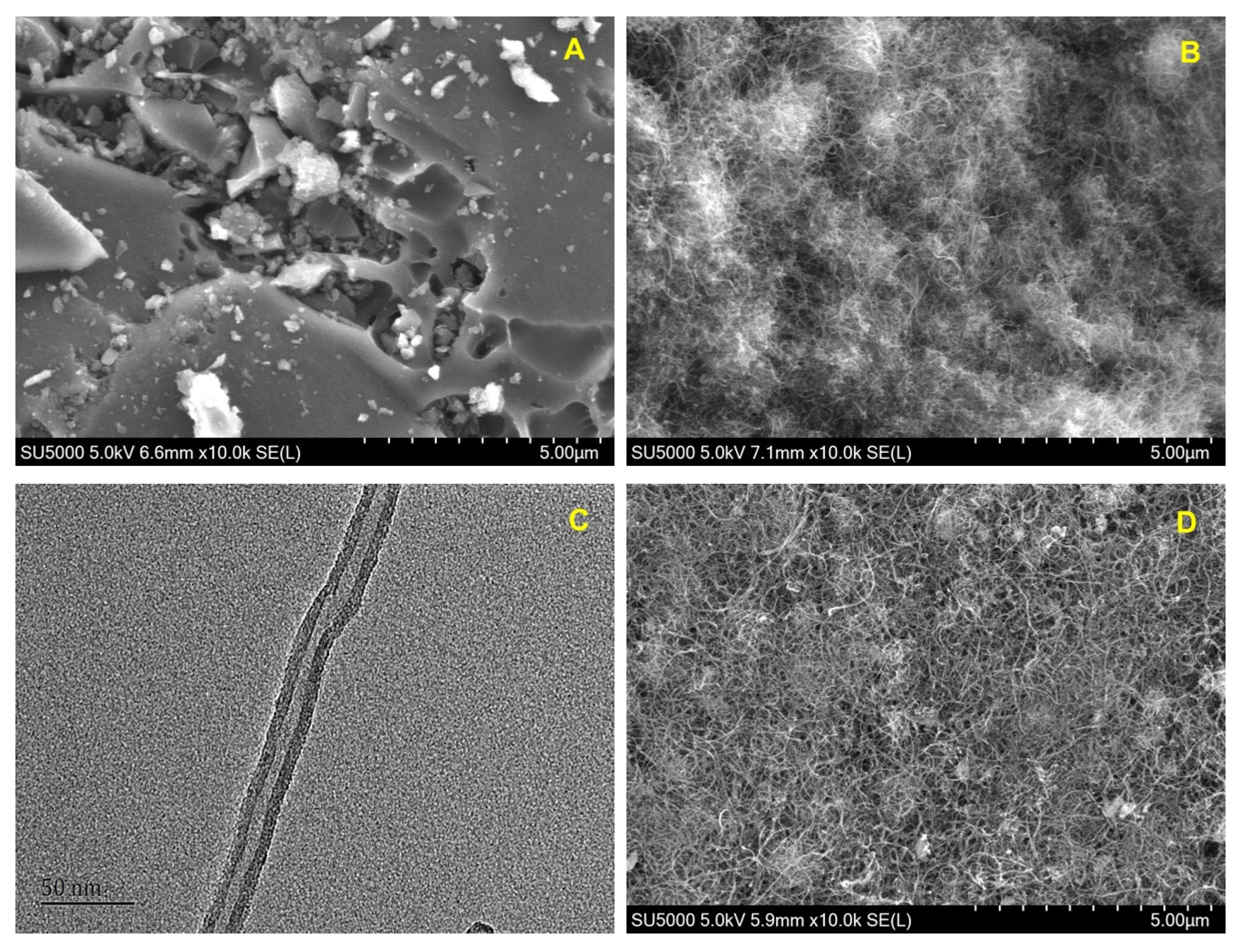
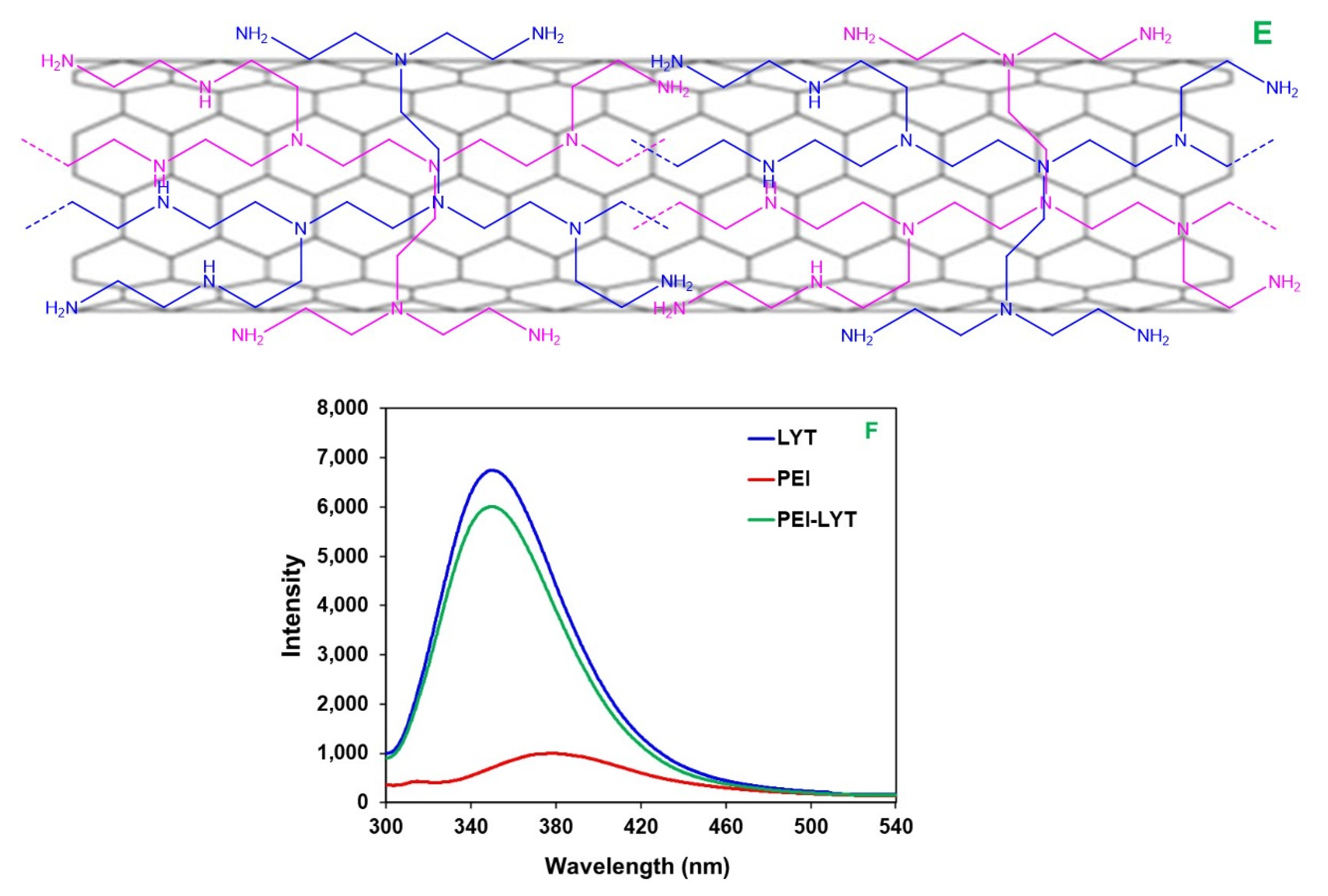
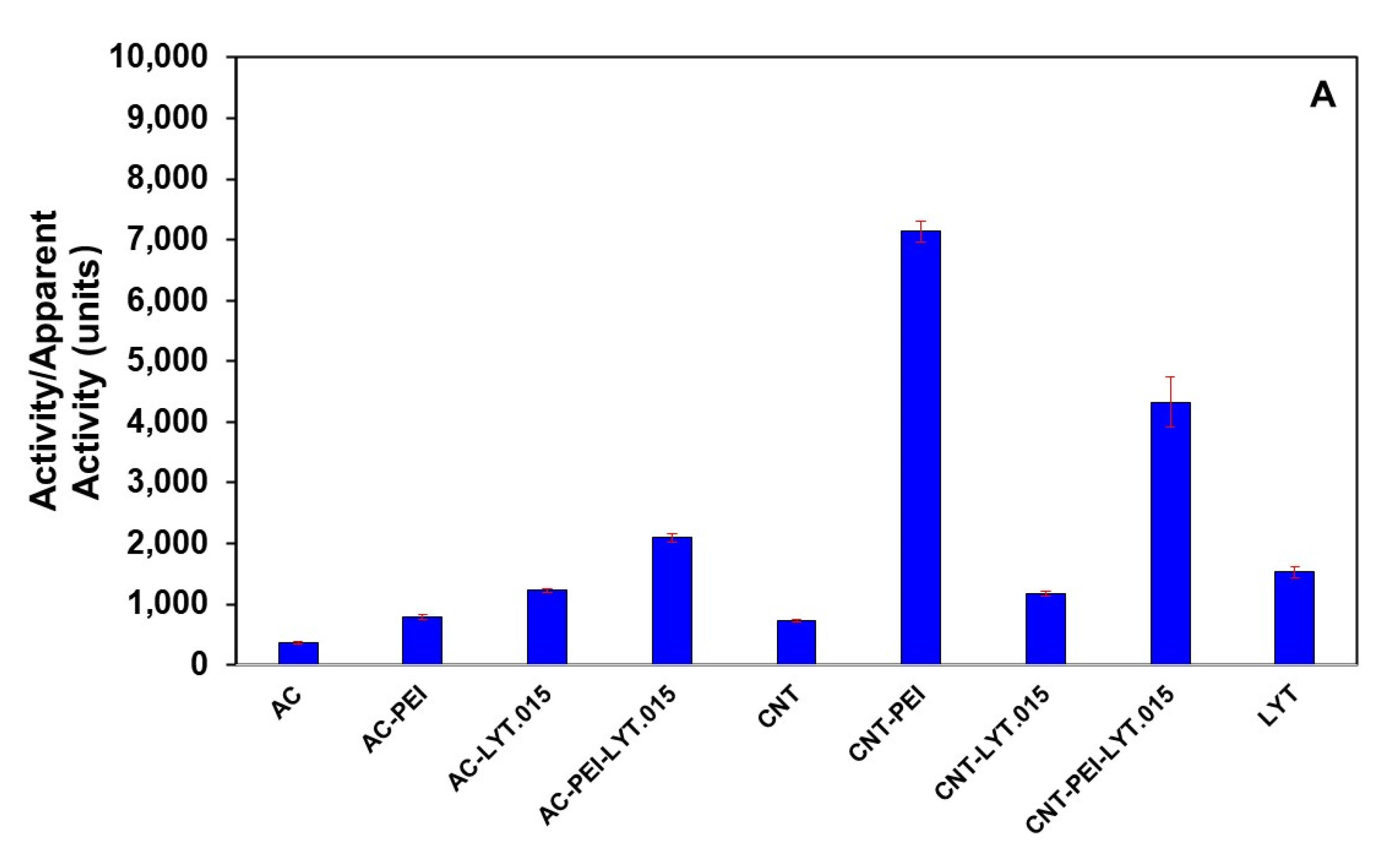
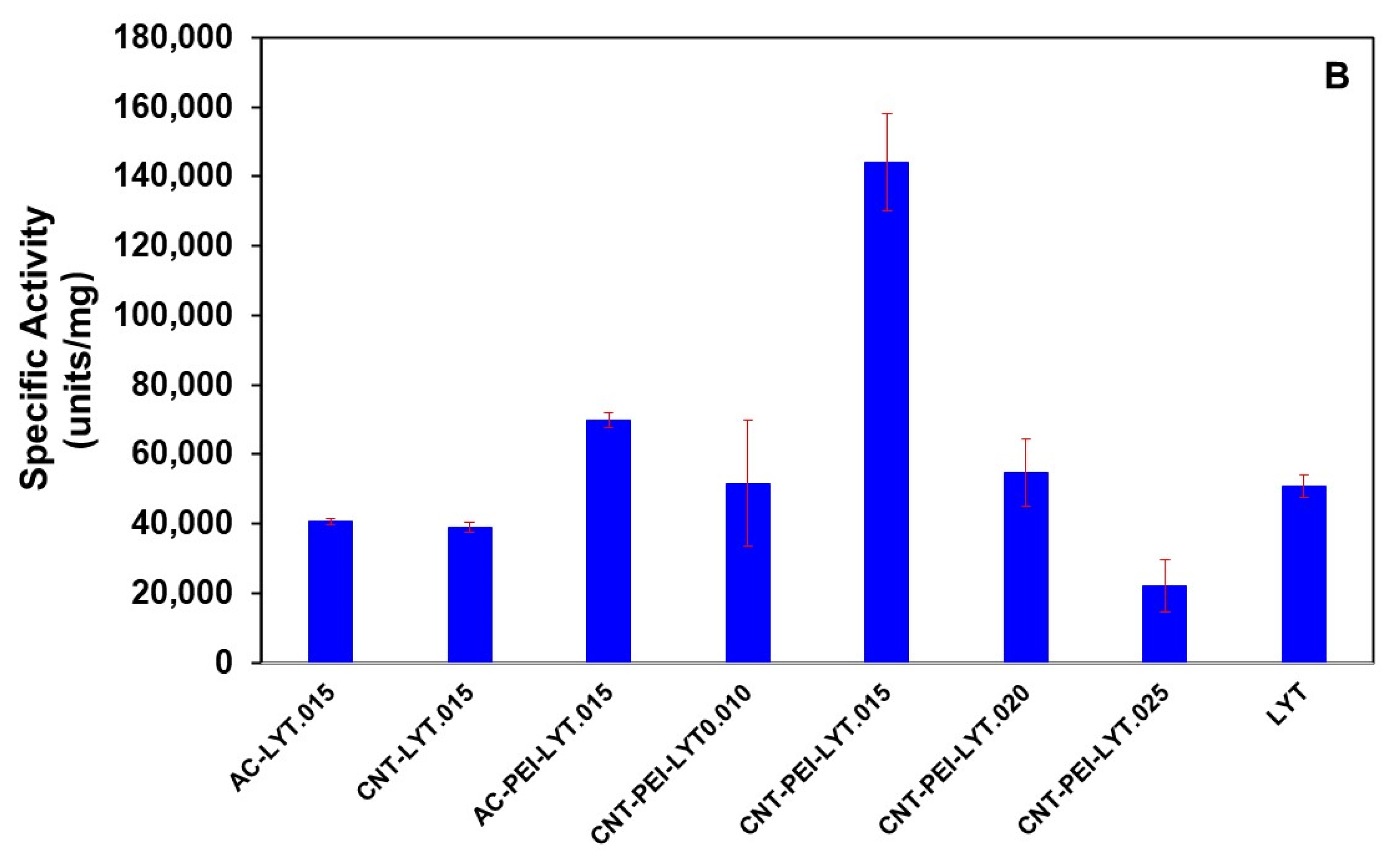

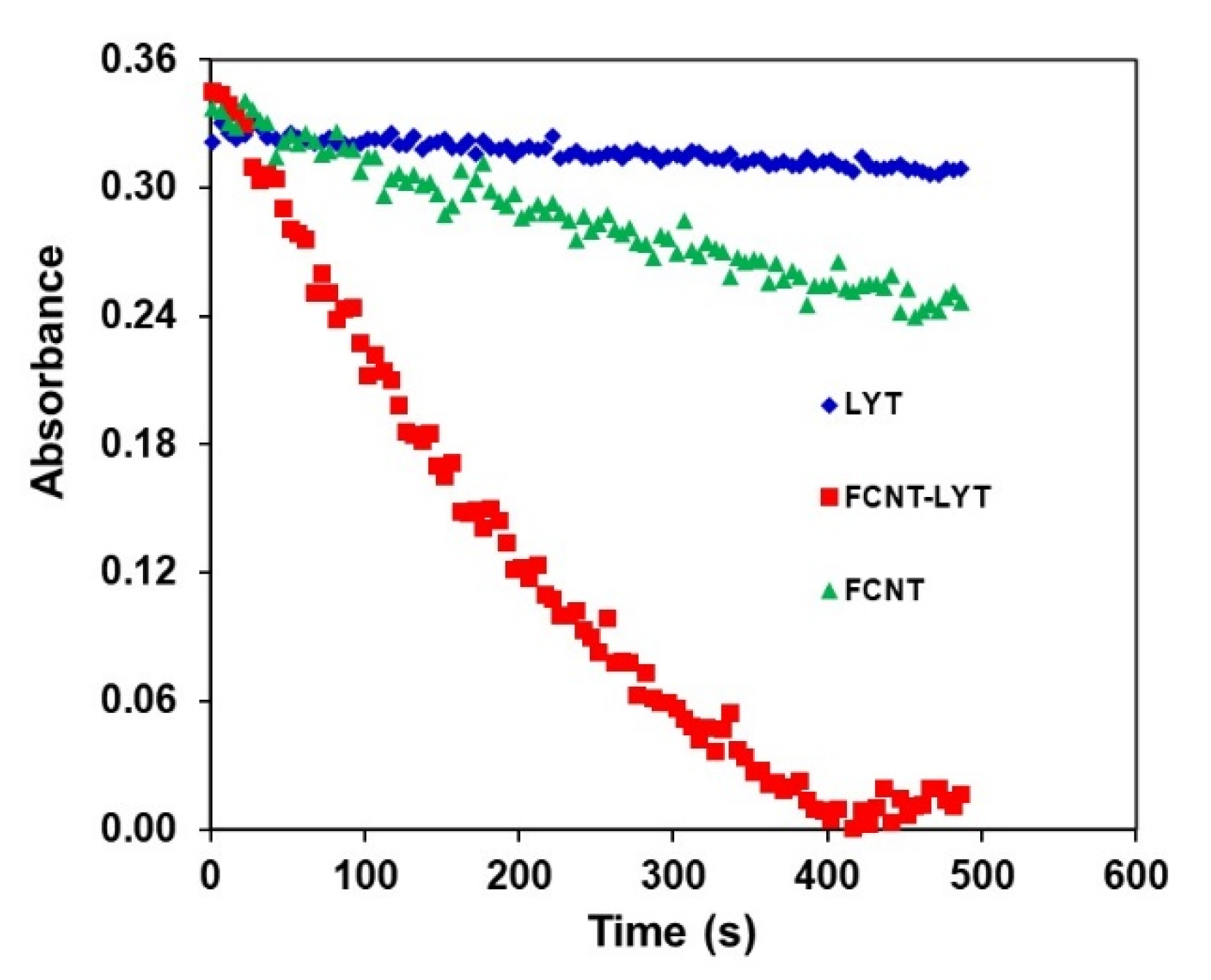
Publisher’s Note: MDPI stays neutral with regard to jurisdictional claims in published maps and institutional affiliations. |
© 2022 by the authors. Licensee MDPI, Basel, Switzerland. This article is an open access article distributed under the terms and conditions of the Creative Commons Attribution (CC BY) license (https://creativecommons.org/licenses/by/4.0/).
Share and Cite
Liang, W.; Chen, M.; Li, L.; Yan, L.; Wang, X.; Wu, X.; Lei, C. Polyethyleneimine-Functionalized Carbon Nanotubes Enabling Potent Antimycotic Activity of Lyticase. Polymers 2022, 14, 959. https://doi.org/10.3390/polym14050959
Liang W, Chen M, Li L, Yan L, Wang X, Wu X, Lei C. Polyethyleneimine-Functionalized Carbon Nanotubes Enabling Potent Antimycotic Activity of Lyticase. Polymers. 2022; 14(5):959. https://doi.org/10.3390/polym14050959
Chicago/Turabian StyleLiang, Weibing, Ming Chen, Lin Li, Liqiang Yan, Xiuli Wang, Xiongzhi Wu, and Chenghong Lei. 2022. "Polyethyleneimine-Functionalized Carbon Nanotubes Enabling Potent Antimycotic Activity of Lyticase" Polymers 14, no. 5: 959. https://doi.org/10.3390/polym14050959
APA StyleLiang, W., Chen, M., Li, L., Yan, L., Wang, X., Wu, X., & Lei, C. (2022). Polyethyleneimine-Functionalized Carbon Nanotubes Enabling Potent Antimycotic Activity of Lyticase. Polymers, 14(5), 959. https://doi.org/10.3390/polym14050959





